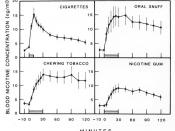Cigarette smoking is the leading cause of preventable deaths in all the developed countries. Despite increased federal and state initiatives (as well as those of numerous non-governmental organizations) to combat this affliction in the United States, the response to the anti-smoking campaign has been mixed at best. Though there has been a decrease in male smoking as a whole, however, this victory is weakened by the increase in smoking among females. The campaigns have also spurred a change in the habit's demographic, as current smoking in the United States is positively associated with younger age, lower income, reduced educational achievement, and disadvantaged neighborhood environment (Krogh 115). But puzzling statistics point out that factors beyond demographics contribute to the problem. Throughout the scientific community, conclusive links between depression and cigarette smoking have been found regardless of demographic. And although it has been proven that cigarettes are comparable in addictivity to Heroin (Seppa), scientists were baffled to find that only one third of all beginning smokers become regular users (Pomerleau).
Increasingly scientists are seeking out (and finding) cohesive genetic links to aspects of tobacco use. Scientists have thus far identified a gene in part responsible for cigarette addiction as well as a certain genotype that significantly increases the probability of commencing tobacco use. The implications of these findings are immense. By developing an understanding of the complexities of the habit, anti-smoking campaigns of the future will be able to far more effectively combat the killer and save millions of lives.
Long before smoking began to be thought of as a societal affliction, scientists began to see evidence of an inherited predisposition to smoke. As early as 1962, scientists stumbled upon the possibility of heritability in conjunction with smoking by examining the habits of several sets of identical twins (Krogh 116). The...


